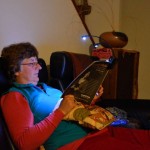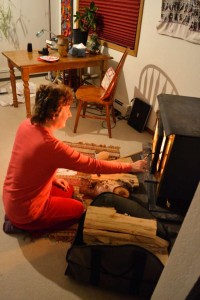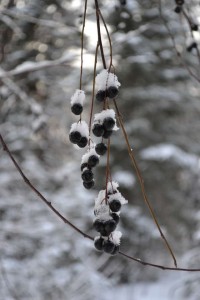We had a nice snowfall last weekend that ended in time to clear the driveway on Sunday afternoon. It was a good, 8-10 inch powder that had the skis rattling in the racks in anticipation. But a late warm front blew in mid-week and wreaked havoc in the Fairbanks area. On Wednesday morning I got up early to do some writing before having to give it up and go in to work. (It’s not possible to get any serious writing done at work, unfortunately.) Rose had gone in but had come back shortly afterwards—her trusty CRV’s defroster couldn’t keep her windshield free of ice. Although the temperature was in the teens, a very fine drizzle was falling and freezing on contact. It took me almost 20 minutes to chisel the incredibly hard accumulation off of my windshield, but the drizzle had turned to snow, so I had no trouble getting in with a clean windshield (though I kept the heat off and the window open to keep it cold and prevent any melt-and-stick). Not many people were in at work, and meetings were being cancelled. One of our dedicated staff described an hour-long commute on the way in, stopping often to manually clean the windshield. Yuck.
By the end of the day we had several inches of heavy snow, and it was continuing to get warmer. Finally, by evening it was raining. A wind was picking up, too, and by the time we went to bed the weather was seriously ugly. Tired, I went right to sleep and slept well all night long, although I did notice that the power had gone out. Rose couldn’t believe I could sleep through what she described as what sounded like herds of horses running around the house and numerous loud explosions. The amount of forest debris on the ground the next morning told the story of the wind, as did the power being out. The explosions were apparently both lighting (!) and blowing fuses on the power grid. Thursday morning I worked at home to clean things up a little and make sure we could be without power for the day before going in. It was good to have waited until the chain saws in the neighborhood had gone quiet. Two trees that had fallen and blocked the road had been removed.
Thursday’s attendance at the university was even lower than Wednesday’s, despite being an oasis of energy. The University has its own (aging) power plant, and it was keeping campus going just fine. After my last meeting ended at about three, I called home to see if the power was back on. No answer and no answering machine said that the answer was no. So I madly printed off a mighty stack of applications that I needed to digest by the next morning and zipped on home to split wood. It’s been really busy, with little time to attend to chores, so we were down to dregs on the split-wood pile and we needed more to keep the stove burning and the house heated. I used the last light of the day to remedy that situation. Rose had stayed to keep the home fires burning, so with warmth assured we began figuring out where we’d stored all of our stuff that we needed to function in the dark. Flashlights, batteries, camp stove, and lantern were pulled out of odd places and most were put to work. The camp stove’s pumping mechanism was kaput, and I couldn’t fix it. Rose figured we could make dinner on the wood stove. She was right! As we had our tasty camp victuals I realized that we had fully four alternate means with which to cook, and only one of them was not working properly.
 So we camped out in the living room with the lantern hung high, and we read and listened to music on cassette tapes. In digging through a drawer of battery operated stuff, Rose had found her old Walkman and small speakers. The tapes had been in a pile to deal with for awhile (what to toss, what to keep?), and they seemed really happy to participate. After replacing the tape player’s long-dead batteries, we listened to some great music we had not heard in too long. I steadily read applications until I’d gotten through them all. Having no power is another way to bring the mind to a tight focus, once the chores are done. (Rose here—Being off the grid is also a great opportunity to enjoy the quiet, to find great satisfaction in knowing that you are able to meet the challenge of keeping your life running smoothly, and to entertain yourself with simple things—all undisturbed by TV, phone calls, computers, etc.)
So we camped out in the living room with the lantern hung high, and we read and listened to music on cassette tapes. In digging through a drawer of battery operated stuff, Rose had found her old Walkman and small speakers. The tapes had been in a pile to deal with for awhile (what to toss, what to keep?), and they seemed really happy to participate. After replacing the tape player’s long-dead batteries, we listened to some great music we had not heard in too long. I steadily read applications until I’d gotten through them all. Having no power is another way to bring the mind to a tight focus, once the chores are done. (Rose here—Being off the grid is also a great opportunity to enjoy the quiet, to find great satisfaction in knowing that you are able to meet the challenge of keeping your life running smoothly, and to entertain yourself with simple things—all undisturbed by TV, phone calls, computers, etc.)
 We brought buckets of snow inside to melt for flushing toilets, and we put a big bowl of snow on the top shelf of the refrigerator to keep things in there cool. With the temperatures dropping, we banked the wood stove and went to bed in the dark, admiring a light snow falling from thin clouds under a waxing moon. One reloading of the wood stove in the night kept the house warm enough, and the next morning we were back at work. Attendance was much improved over the past two storm days. The University very rarely closes due to weather, and this was one time when a lot of people used their own judgement about whether it was safe to travel.
We brought buckets of snow inside to melt for flushing toilets, and we put a big bowl of snow on the top shelf of the refrigerator to keep things in there cool. With the temperatures dropping, we banked the wood stove and went to bed in the dark, admiring a light snow falling from thin clouds under a waxing moon. One reloading of the wood stove in the night kept the house warm enough, and the next morning we were back at work. Attendance was much improved over the past two storm days. The University very rarely closes due to weather, and this was one time when a lot of people used their own judgement about whether it was safe to travel.
But with falling temperatures and without power, getting things into better shape for what was now proving a long-term outage was essential. After my last obligation of the day ended at four, I raced across town to pick up some kerosene. Lowe’s had only one lonely gallon left. It came home with me. As long as I was there, I also picked up 240 pounds of pea gravel in four bags to add to the ~600 lbs already in the back of my truck. Ice-covered roads in warmer temperatures, say, above 10̊ F, are slippery. I’d felt the rear end break free a couple of times (despite studded tires) and had seen several near-accidents in the past couple of days. The extra weight was noticeable and had a positive effect as I went in search of more kerosene. It seems like every time I have to go to Lowe’s or Home Depot I don’t find everything I need and have to go to the other one. And that night was no exception. While I obtained the last gallon of kerosene left at Lowe’s, Home Depot had an arsenal of five-gallon cans, so I left with more than I actually needed (another hazard of the box store), and home I raced. Back in 1997, a friend had left us his kerosene heater, and we figured that in Alaska it might come in handy, so we’d packed and shipped it with our household goods. We had run it once in Virginia, but here in Alaska it had waited patiently to be called upon. Despite the long wait, it was ready for duty. My idea was to put it into the crawl space to warm that up directly so that the water pipes (for baseboard heating and the water supply) would stay in the happy zone.
Rose and I had coordinated our presence at home, with both of us being gone for just a few hours mid-day. So when I got home Rose had the woodstove going again, which is critical when it’s the sole heat source in the house. I turned to the old kerosene heater. I had to read the manual to get it working, but it rose to the challenge like a champ and sat there heating up the universe while I feverishly worked on other things. It seemed like a good idea to fuel it up and start it outside before sticking it under the house. I’d heard on the radio just that morning that one of the most common causes of house fires was auxiliary heating devices. While I knew there were a lot of those devices running in Fairbanks under these conditions, we did not want to be a house that added to that statistic. So, leaving it there to equilibrate, I crawled under the house to see what was going on. First I grabbed the remote temperature sensor that I’d put under there several years ago to monitor winter temperatures after we’d added a bunch of insulation to keep it cooler. The batteries had run out long ago, but we needed the device’s services again. Then I went around to the cold spots where we’d frozen up once before (too much insulation) to feel for the current status. It seemed sufficiently above freezing still (by touch), so I next played with the electronics of the temperature transmitter and receiver to get these devices functioning again. Of course it was much more labor intensive than just changing batteries. So I put that task aside and worked with Rose to empty the freezers so we could put things outside to stay frozen in a dog-proof manner. We don’t have dogs, but we often see their tracks in the yard. Then there’s the red fox, too.
That took awhile, but soon we were defrosting both freezers (might as well) and surveying the situation. I turned off the kerosene heater and decided we could put it under the house in the morning, when it would be easier to monitor its progress in generating heat and carbon monoxide (the CO monitor needed batteries, too). We had a few more things to do to be ready for a cold, powerless night, and pretty soon it was 8 p.m. and we hadn’t started cooking anything. We were missing a great candlelight potluck, to our chagrin, but at least we knew that the house was in good shape for an even longer power outage. It took us awhile to learn and invent the drill, but we were confident that we could keep the cold things cold and the warm things warm. A couple of toilet flushes with the thawed buckets of snow, a renewal of the snow bowl in the fridge, and a tasty dinner cooked on the woodstove and grill and we were happy campers, finally settling down to read for pure entertainment.
Our power returned on Saturday at around 5 a.m., about 54 hours after going out. We (and the house) were still in great shape, but we were some of the lucky ones. Golden Valley Electric Association had notices out on Saturday and Sunday that those still without power should expect to be that way for days more. And, with temperatures down below zero, that’s a place nobody wants to be. Too late to be of any use in this situation, I finally did get the temperature monitoring system to work again after sanding electrical contacts and rebooting the whole thing about six times. It’s a nice mental crutch to be able to stand in the kitchen and see what’s going on in the cold spot under the house. We’re going to hook up our automated thermal alarm, too, because temperatures around -30̊ F are predicted in a few days. With this experience and practice, we think we’re ready for next time. From the time it was built in 1984 until now, this home has experienced two extended power outages. That’s about one every 15 years. As we hear all the time about the stock market, past performance is not a reliable indicator of future results. So we’re sort of scratching our heads about what we may wish to do to make next time work a bit more smoothly. It’s going to take a bit more than replacing the camp stove pump.


Holy Adventure, Batman! And I thought having my furnace out for a few days was a pain in the arse. Not so much.
Wow! New challenges on a daily basis. Not fun, but love reading about it!! Great blog!!!
Fun to read. Not fun to experience. Good thing you two are innovators. Lot’s of challenges with your sub-zero temps!!
LOVE the new blog!!
You make a horrible experience sound down-right exciting!
I can’t wait for John to read this, he loves being ready for emergencies, and I think you’ve added a few things he may need for our arsenal!
Love the photos of Rose – Hi Rose!